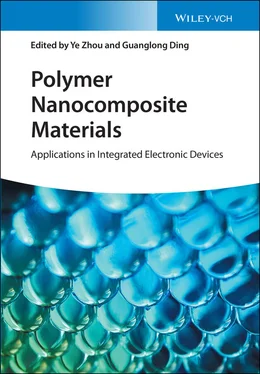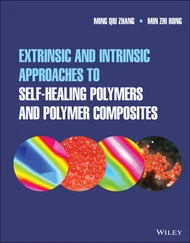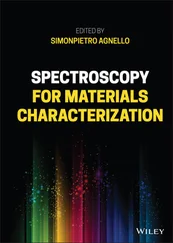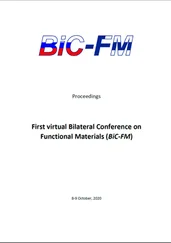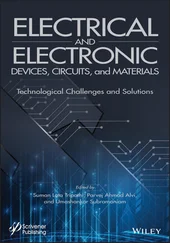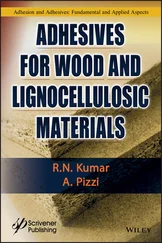1 ...8 9 10 12 13 14 ...21 
where σ 0represents the intrinsic conductivity of the fillers, t represents the electrical conductivity exponent, ϕ represents the volume fraction of conductive particles, and ϕ crepresents the volume fraction at percolation transition [21]. In a random conducting network, the exponent t only depends on the dimensionality of the network [22], which is called universal percolation behavior. Theoretical calculation suggests that t = 1–1.3 corresponds to two-dimensional networks, while t = 2.0 represents a three-dimensional network. The percolation threshold and electrically conductivity are affected by many factors such as nanofiller dimension and microstructure of the CPCs. For example, conductive nanofillers with a large aspect ratio (CNTs, graphene nanosheet) could form well connected conductive network, which is beneficial to a low percolation threshold in CPCs [23–25]. It is also reported that nanofiller filled CPCs exhibit better electrical and mechanical properties than CPCs incorporated with microsized fillers [26, 27]. Also, the electrically conductive behavior of CPCs has strong relationship with the structure of conductive network in the polymer matrix. The perfect interconnection between conductive nanofillers and formation of 3D continuous pathway in the polymer matrix are regarded as the key factor for construction of the conductive network [28]. As a result, the morphology and distribution of nanofiller in the polymer matrix play an important role determining the electrical conductivity of CPCs. The fabrication process and parameters can greatly influence the morphology of conductive network in polymer matrix and thus their electrical properties. There are many methods for fabrication of CPCs have been reported, among which melt blending, solution mixing and in situ polymerization are regarded as three major methods. However, it still remains challenge to prepare high performance CPCs with low percolation threshold while high conductivity [29, 30].
Melt blending is processed by using kneading machine, molding machine, internal mixer or double screw extruder, etc. [31, 32] to evenly mix the polymer matrix and conductive fillers with the processing temperature above the melting point of polymer. Thus, high temperature and high shear force are needed in melt blending process to ensure the homogeneous dispersion of the conductive nanofiller in the melting polymer matrix. During the melting blending, the nanofillers are forced to disperse by the mechanical shear force and at the same time prevented from re-aggregation by the viscous polymer matrix. After the masterbatch is obtained, the final CPCs can be prepared by using different polymer processing technologies like spinning, hot press, and injection molding [33–35]. Melt blending is an environmental-friendly process method and is feasible for large-scale industrial production of the CPCs. Many recent studies have investigated the effect of fillers introduction, dispersion state, and processing factors on the physical and electrical properties of the CPCs prepared by the melt blending [36].
Kim [37] studied the influence of the CNTs concentration and dispersion state on thermal, rheological, and mechanical properties of the polybutylene terephthalate (PBT) nanocomposites. It was found that the storage and loss moduli of the composite increased with the increase of the CNTs content. The interaction between nanotube–nanotube and polymer–nanotube was regarded as the main cause for the nonterminal behavior of the PBT nanocomposites. Besides, it can be found that the heat distortion temperature and the thermal stability of the composite were substantially enhanced at a low CNTs concentration. During the melt blending, the interaction between conductive fillers and polymer matrix greatly influences the dispersion state of the filler. For example, due to the interaction of π–π stacking between graphene and polystyrene (PS), the graphene could be easily dispersed in PS matrix during the melt blending [38]. It can be seen in Figure 2.1a that the suspension of PS/graphene without melting blending is transparent, suggesting the absence of graphene in the suspension. However, the solubility of graphene in toluene is greatly enhanced by prolong the melt blending time (5–60 minutes). This dark-colored suspension keeps stable and homogeneous even after three months or longer. The forming of π–π stacking between PS and graphene sheet in melt blending process is schematically demonstrated in Figure 2.1b. In melt blending, the PS chains were stretched by shear forces, forming some closely aligned aromatic rings parallel to the graphene sheet. Therefore, the interaction between PS and graphene was enhanced.
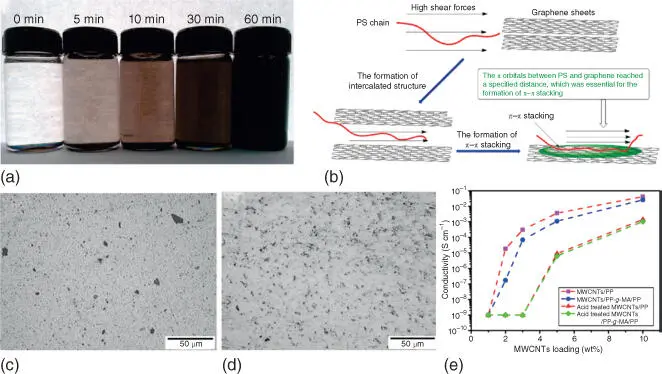
Figure 2.1 (a) Photographs of the PS/graphene/toluene suspension prepared by centrifuged at 8000 rpm for 30 minutes. (b) Schematic illustration for the formation of π–π stacking between graphene and PS in melt blending process. Source: (a)–(b) Reproduced with permission. [38] Copyright 2011, American Chemical Society. Microscopic morphology of (c) 1% pristine MWCNTs/PP; (d) 1% pristine MWCNTs/PP- g -MA/PP. (e) Electrical conductivity of various PP composites. Source: (c)–(e) Reproduced with permission. [39] Copyright 2009, Elsevier Ltd.
But mostly graphene and CNTs tend to aggregate in the polymer matrix [polymethyl methacrylate (PMMA), polystyrene- block -poly(ethylene- co -butylene)- block -polystyrene (SEBS), polypropylene (PP)] [40, 41]. To solve this problem, compatibilizers, chemical modification, or surfactants have often been used to improve the interaction between the filler and the nonpolar polymer matrix [42–44]. Pan et al. [39] studied the correlation between the dispersion state of multiwalled carbon nanotubes (MWCNTs) in PP and electrical conductivity of its composite. They adopted two methods to achieve the uniform dispersion of MWCNTs in PP matrix. One is chemical modification of MWCNTs and another one is incorporation of a master batch [polypropylene- grafted -maleic anhydride (PP- g -MA)] as a compatibilizer followed by simple melt blending. Through comparing the optical microscopic images of MWCNTs dispersion in PP in Figure 2.1c,d, we can get that the addition of compatibilizer could largely enhance the uniform dispersion of MWCNTs in PP matrix. Although the interfacial interaction between MWCNTs and PP could enhance the dispersion of MWCNTs, it may cause the reduction of the electrical conductivity of the composites ( Figure 2.1e). Meanwhile, post-heat treatment can improve the connection of MWCNTs in the composite, leading to the increase of the electrical conductivity. Herein, a balance between uniform dispersion of CNTs and construction of conductive networks is vital to the enhancement of electrical conductivity for composites.
In short, melt blending is a simple method to fabricate CPCs. The electrical properties of the CPCs are strongly dependent on the processing parameters like mixing time, shear stress, and temperature as well as the surface modification and introduction of compatibilizers.
Although melt blending is a useful and feasible processing method for the large-scale industrial production of the CPCs, the volume concentration of conductive particles is usually higher than 5% to obtain the composite with a high conductivity [45]. Such a high content of fillers would largely increase the melt viscosity [46, 47] and thus make the processing less smooth and also increase the cost of the material fabrication. As an alternative, solution mixing method can tackle this issue, because the nanofillers can be diluted in solvent to achieve relatively good dispersion [48, 49].
Читать дальше
